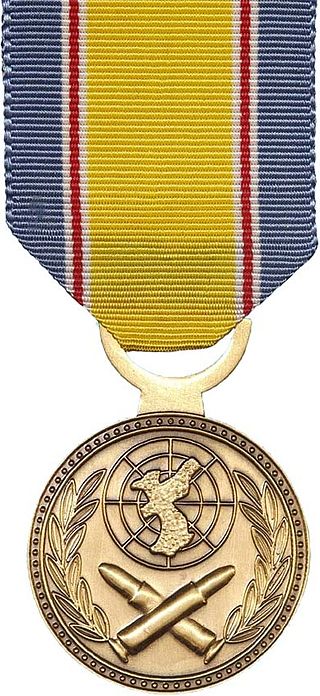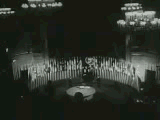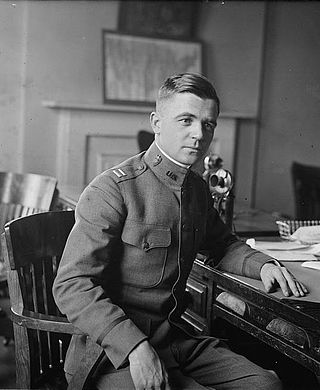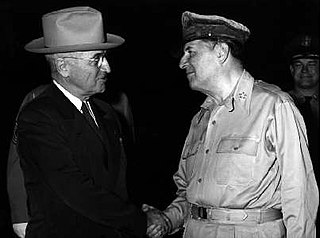Related Research Articles

The Korean War was an armed conflict on the Korean Peninsula fought between North Korea and South Korea and their allies. North Korea was supported by the People's Republic of China and the Soviet Union, while South Korea was supported by the United Nations Command (UNC) led by the United States. The conflict was the first major proxy war of the Cold War. Fighting ended in 1953 with an armistice but no peace treaty, leading to the ongoing Korean conflict.

The Korean War Service Medal, also known as the Republic of Korea War Service Medal (ROKWSM), is a military award of South Korea which was first authorized in December 1950.

The history of the United Nations has its origins in World War II beginning with the Declaration of St James's Palace. Taking up the Wilsonian mantle in 1944–1945, US President Franklin D. Roosevelt pushed as his highest postwar priority the establishment of the United Nations to replace the defunct League of Nations. Roosevelt planned that it would be controlled by the United States, Soviet Union, United Kingdom and China. He expected this Big Four would resolve all major world problems at the powerful Security Council. However the UN was largely paralyzed by the veto of the Soviet Union when dealing with Cold War issues from 1947 to 1989. Since then its aims and activities have expanded to make it the archetypal international body in the early 21st century.

United Nations Command is the multinational military force established to support the Republic of Korea during and after the Korean War. It was the first international unified command in history, and the first attempt at collective security pursuant to the Charter of the United Nations.

Dwight D. Eisenhower's tenure as the 34th president of the United States began with his first inauguration on January 20, 1953, and ended on January 20, 1961. Eisenhower, a Republican from Kansas, took office following his landslide victory over Democratic nominee Adlai Stevenson in the 1952 presidential election. Four years later, in the 1956 presidential election, he defeated Stevenson again, to win re-election in a larger landslide. Eisenhower was limited to two terms and was succeeded by Democrat John F. Kennedy, who won the 1960 presidential election.
The Office of Defense Mobilization (ODM) was an independent agency of the United States government whose function was to plan, coordinate, direct and control all wartime mobilization activities of the federal government, including manpower, economic stabilization, and transport operations. It was established in 1950, and for three years was one of the most powerful agencies in the federal government. It merged with other agencies in 1958 to become the Office of Civil and Defense Mobilization (1958–1961).
The aftermath of the Korean War set the tone for Cold War tension between superpowers. The Korean War was important in the development of the Cold War, as it showed that the two superpowers, United States and Soviet Union, could fight a "limited war" in a third country. The "limited war" or "proxy war" strategy was a feature of conflicts such as the Vietnam War and the Soviet War in Afghanistan, as well as wars in Angola, Greece, and the Middle East.

Australia entered the Korean War on 28 September, 1950; following the invasion of South Korea by North Korea. The war's origins began after Japan's defeat in World War II, which heralded the end to 35 years of Japanese occupation of the Korean Peninsula. The surrender of Japan to the Allied forces on 2 September 1945 led to the division of Korea into two countries, which were officially called the Democratic People's Republic of Korea (DPRK) and the Republic of Korea (ROK). The DPRK was occupied by the Soviet Union, and the ROK, below the 38th Parallel, was occupied by the United States (US).

The Turkish Brigade, codenamed North Star, was a military formation from Turkey that served under the United Nations Command during the Korean War.
The Department of Post-War Reconstruction was an Australian Government department responsible for planning and coordinating Australia's transition to a peacetime economy after World War II. The department was established in December 1942 and dissolved in March 1950.

Lieutenant General John Breitling Coulter was a senior United States Army officer. Enjoying a distinguished 40-year military career, Coulter served during World War I, World War II and the Korean War.

Allegations that the United States military used biological weapons in the Korean War were raised by the governments of the People's Republic of China, the Soviet Union, and North Korea. The claims were first raised in 1951. The story was covered by the worldwide press and led to a highly publicized international investigation in 1952. Secretary of State Dean Acheson and other American and allied government officials denounced the allegations as a hoax. Subsequent scholars are split about the truth of the claims.

The Menzies government (1949–1966) refers to the second period of federal executive government of Australia led by Prime Minister Robert Menzies. It was made up of members of a Liberal–Country Party coalition in the Australian Parliament from 1949 to 1966. Menzies led the Liberal–Country Coalition to election victories in 1949, 1951, 1954, 1955, 1958, 1961 and 1963. Robert Menzies was Australia's longest serving prime minister. He had served a previous term as prime minister as leader of the United Australia Party from 1939 to 1941. Although he would retire in 1966, his party would remain in office until 1972, an unprecedented 23 years of government from nine consecutive election victories.

The following events occurred in July 1950:
The Canadian Forces were involved in the 1950–1953 Korean War and its aftermath. More than 30,000 Canadians participated on the side of the United Nations, and Canada sent eight destroyers. Canadian aircraft provided transport, supply and logistics. 516 Canadians died, 312 of which were from combat. After the war, Canadian troops remained for three years as military observers.

The following events occurred in September 1950:

The United Nations Memorial Cemetery in Korea, located at Tanggok in the Nam District, City of Busan, Republic of Korea, is a burial ground for United Nations Command (UNC) casualties of the Korean War. It contains 2,300 graves and is the only United Nations cemetery in the world. Laid out over 14 hectares, the graves are set out in 22 sites designated by the nationalities of the buried servicemembers.

The following events occurred in October 1950:

Major General Charles Edward Maurice Lloyd, CBE was a senior officer in the Australian Army. Lloyd graduated from the Royal Military College, Duntroon in 1918 as a regular officer in the artillery and subsequently served in a range of staff and regimental positions in the inter-war years. He later saw service in the Second World War, during which he held senior staff and administrative positions in the Middle East, the Netherlands East Indies, Papua and Australia. Later he worked as a newspaper executive, as chief of several United Nations agencies, and in private enterprise. Lloyd died in 1956.

The main issues of the United States foreign policy during the 1945–1953 presidency of Harry S. Truman include:
References
- Dennis, Peter; Grey, Jeffrey; Morris, Ewan; Prior, Robin; Bou, Jean (2008). The Oxford Companion to Australian Military History (Second ed.). Melbourne: Oxford University Press. ISBN 978-0195517842.
- Lyons, Gene M. (1958). "American Policy and the United Nations' Program for Korean Reconstruction". International Organization. 12 (2): 180–192. doi:10.1017/s0020818300008535. S2CID 153663225.